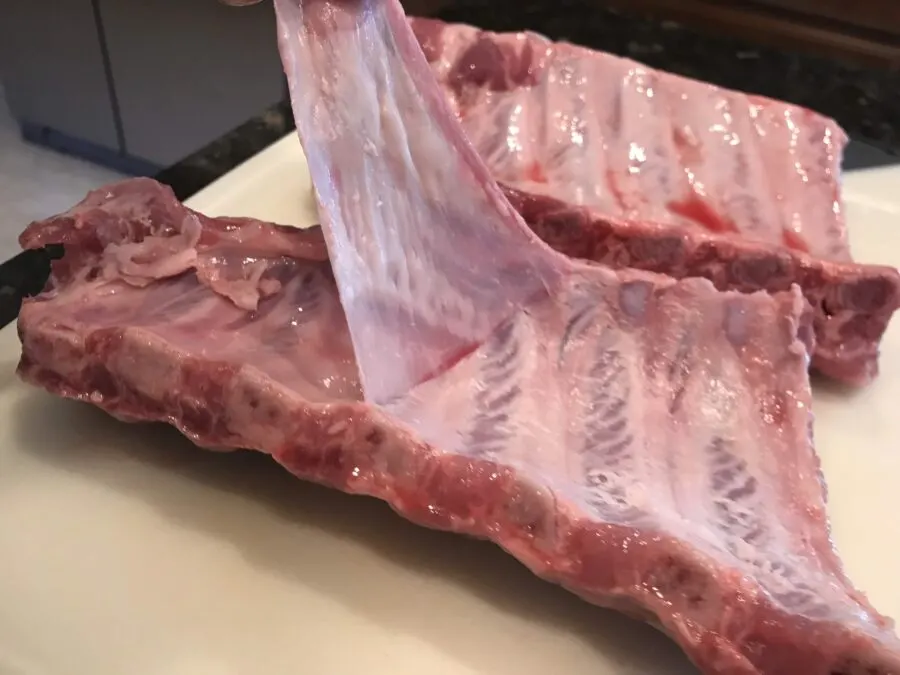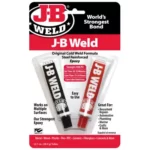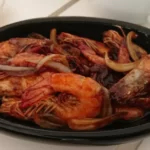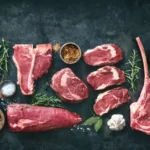Slow-cooked, smoked, or grilled – ribs are a staple in the world of barbecues. A big part of their appeal lies in the tender meat that just seems to melt in your mouth. But what about that layer on the bottom of the ribs? The silver-colored membrane often causes confusion for many people when it comes to preparation and consumption.
This layer, also known as the rib membrane, is technically edible. However, the debate over whether or not to remove it before cooking is widespread among cooking enthusiasts and professional chefs alike. Some argue that keeping it on results in more flavorful ribs, while others claim it negatively affects the tenderness and taste.
The rib membrane topic is more than a simple yes or no question. Several factors come into play when deciding whether to eat the membrane on ribs, from cooking techniques to health considerations. This article dives deep into these aspects to provide a well-rounded perspective.
What is the Membrane on Ribs?
Definition of Rib Membrane
The rib membrane, or the “pleura,” is a thin layer that coats the bone-side of a rack of ribs. It is silver-grey in color and can feel quite tough and leathery. This membrane primarily functions as a protective layer for the rib cage and is a common feature in both pork and beef ribs.
Significance of the Membrane
The membrane plays a significant role in the animal’s anatomy, but its impact on the culinary world is subject to debate. It can act as a barrier, preventing the penetration of marinades and rubs into the meat. On the flip side, it can also help retain the rib’s fatty juices during the cooking process, potentially enhancing the flavor.
Can You Eat the Membrane?
Safety of Eating Rib Membrane
Indeed, it is completely safe to eat the membrane on ribs. It is not hazardous or harmful and it poses no health risks to humans. Despite its toughness and chewiness, it is fully edible and digestible. However, some diners might find its texture a bit off-putting or not as enjoyable as the tender, flavorful meat of the ribs.
It’s worth mentioning that the texture of the membrane can vary depending on the cooking method used. Slow, prolonged cooking techniques such as smoking or slow roasting can make the membrane less noticeable as it has more time to break down and become tender. However, in faster cooking methods such as grilling or broiling, the membrane might remain tough and chewy.
Effects on Taste and Texture
Eating the membrane does not pose any health risks, but it does impact the culinary experience in terms of both taste and texture. The membrane acts as a barrier that may prevent seasonings, marinades, or smoke (for those who are smoking their ribs) from fully penetrating the meat, resulting in less flavorful ribs.
Moreover, the membrane’s toughness can interfere with achieving that melt-in-your-mouth tenderness that many people love about ribs. Some people find the texture of the membrane unpleasant or annoying as it doesn’t break down as easily as the meat during the eating process.
Pros and Cons of Removing the Membrane
Benefits of Membrane Removal
Removing the membrane before cooking has several advantages:
- Improved Taste: Without the membrane, the ribs can absorb more of the rubs, marinades, and smoke, resulting in deeper and richer flavors.
- Better Texture: Ribs without the membrane are generally more tender and easier to eat. There’s no tough layer to chew through, just the succulent, flavorful meat.
- More Even Cooking: The membrane can act as a barrier to heat, causing the ribs to cook unevenly. Removing it helps to ensure that the heat penetrates the ribs more evenly, leading to better cooking results.
Drawbacks of Membrane Removal
However, removing the membrane does have a few potential downsides:
- Loss of Natural Juices: The membrane can help to lock in the ribs’ natural juices during cooking, keeping them moist and flavorful. Without it, the ribs might dry out more quickly.
- Additional Prep Time: Removing the membrane adds an extra step to the preparation process, which can be a bit tricky and time-consuming, especially for beginners.
- Possible Meat Damage: If not done carefully, removing the membrane might lead to the meat being torn or damaged.
How to Remove the Membrane from Ribs
Necessary Tools for Membrane Removal
To remove the membrane from the ribs, you’ll need just a few tools that are already likely in your kitchen:
- A sharp knife: A small paring knife works best, but any sharp knife will do.
- A paper towel or kitchen towel: This is used to get a firm grip on the membrane.
Step-by-Step Membrane Removal Guide
Here’s a simple step-by-step guide on how to remove the membrane from ribs:
- Locate the Membrane: Place the ribs bone-side up on a cutting board. The membrane is the shiny, silvery layer covering the bones.
- Start at One End: Use the knife to gently lift a corner of the membrane at one end of the rack.
- Grip the Membrane: Once it’s lifted, use the paper towel to firmly grip the membrane. The membrane can be slippery, and the paper towel helps you to hold onto it.
- Pull Off the Membrane: Slowly and carefully pull the membrane away from the ribs, ideally in one smooth motion. It may tear, and if it does, simply start the process again at the point where it tore.
How to Cook Ribs with the Membrane On
Techniques for Cooking Ribs with Membrane
If you decide to leave the membrane on, here are a few cooking techniques to ensure you still end up with a delicious result:
- Slow Cooking: Slow cooking methods, such as smoking or braising, help to break down the toughness of the membrane over time, making it less noticeable.
- Scoring the Membrane: Make shallow cuts or scores in the membrane before cooking. This can aid flavor penetration and also help to make the membrane a bit less tough.
- High Moisture Cooking Methods: Cooking methods that use a lot of moisture, such as braising or slow cooking in a liquid, can help to soften the membrane.
Tips for Enhancing Flavor and Tenderness
Even with the membrane on, there are several ways to enhance the flavor and tenderness of your ribs:
- Generous Seasoning: Don’t skimp on the rub or the marinade. Apply it generously to ensure the ribs are flavorful.
- Long Marinating Time: Allow the ribs to marinate for several hours, or better yet, overnight. This gives the flavors more time to seep into the meat.
- Consistent Cooking Temperature: Maintain a consistent cooking temperature. Sudden changes in temperature can make the meat (and the membrane) tough.
- Resting After Cooking: Let the ribs rest after cooking. This allows the juices to redistribute throughout the meat, leading to more tender and juicy ribs.
How Professional Chefs Handle Rib Membranes
Chefs’ Opinion on Rib Membrane
Many professional chefs remove the rib membrane for a better texture and flavor absorption. However, some keep it on, particularly in specific cooking circumstances.
Different Practices in Various Cuisines
In traditional American barbecue, the membrane is often removed. But in some Asian cuisines, the membrane is left intact to preserve the ribs’ natural flavors and juices.
The Impact on Health: Eating Ribs with Membrane
Nutritional Considerations
There is no significant nutritional difference between ribs cooked with the membrane on or off. However, if the membrane retains more fat during cooking, it could potentially increase the calorie content slightly.
Digestibility of Rib Membrane
The membrane is fully edible and poses no issues with digestibility. It is, however, tougher and chewier than the meat itself, which some people might find less palatable.
Frequently Asked Questions
Does the Membrane Affect Cooking Time?
No, the membrane does not significantly affect cooking time. However, it can impact how effectively seasonings permeate the meat.
Can I Remove the Membrane After Cooking?
Yes, you can remove the membrane after cooking, but it might be more challenging. It’s easier and more efficient to remove it during the prep stage.
Is the Membrane on All Types of Ribs?
Yes, all types of ribs, including baby back ribs, spare ribs, and St. Louis style ribs, have a membrane.
Final Thoughts
When it comes to the question of eating the membrane on ribs, the answer is highly subjective and dependent on personal preferences. It’s a balancing act between flavor absorption, texture, cooking technique, and even cultural tradition.
For the aspiring chef, experimenting is key. Try cooking ribs with the membrane on and off to see which result you prefer. After all, the joy of cooking lies in the journey, the learning, and the delicious, flavorful discoveries you make along the way.
In the end, whether you choose to remove the membrane or keep it on, the most important aspect is to enjoy the process and the meal. And always remember – no matter how you cook your ribs, they’re bound to be a hit when served with a side of good company.







